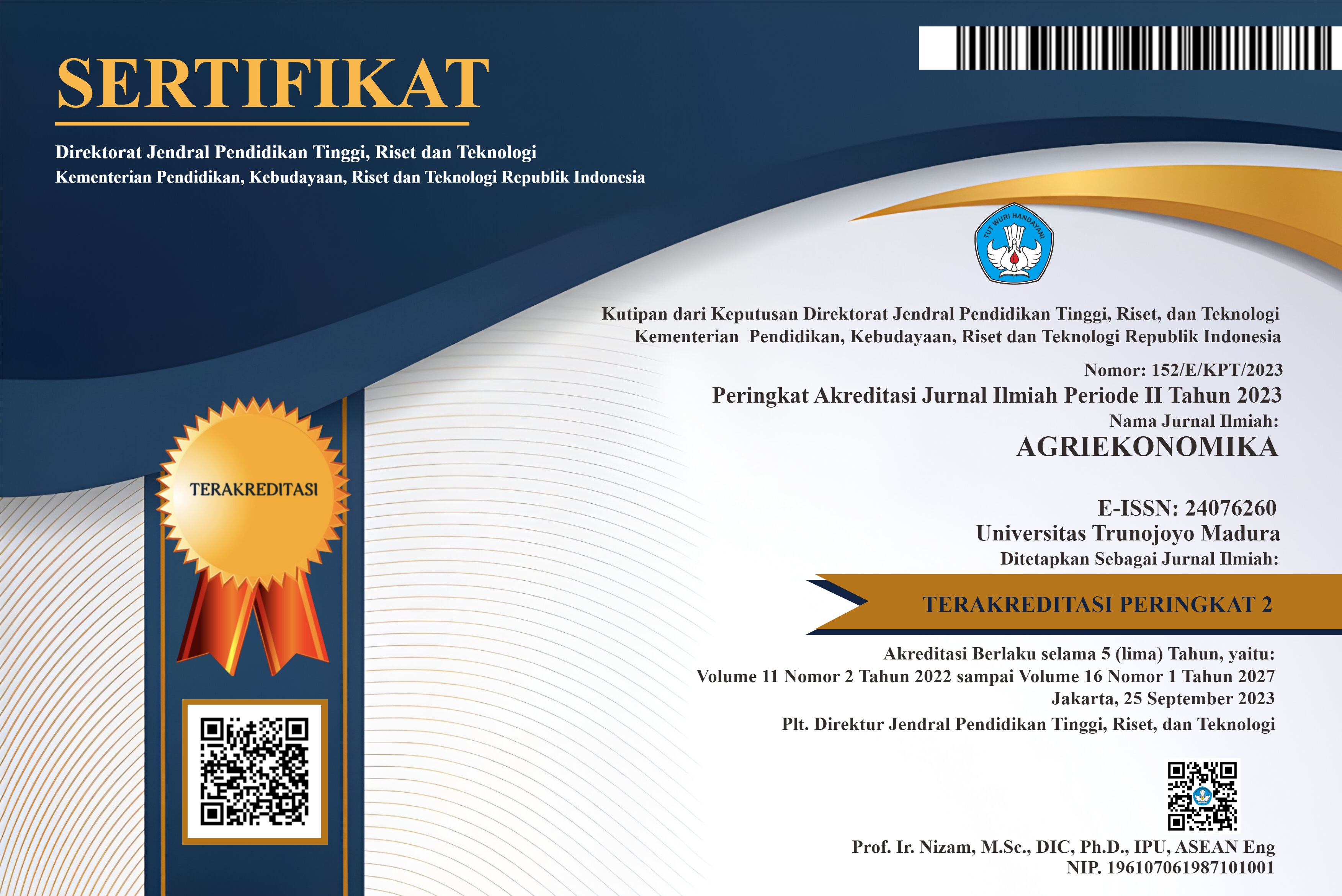HUBUNGAN PENDAPATAN KONSUMEN DAN MOTIVASI PEMBELIAN TELUR AYAM BERLABEL DI KAWASAN YOGYAKARTA
Abstract
ABSTRAK
Trend konsumsi pangan sehat kini terus meningkat terutama di negara-negara berkembang termasuk di Indonesia. Minat masyarakat mengkonsumsi pangan sehat tersebut menjadi peluang bagi para produsen untuk terus mengembangkan produknya. Telur ayam berlabel merupakan telur ayam premium yang dijual dengan kemasan dan label tertentu. Kualitas telur ayam ini diklaim mempunyai keunggulan dibanding telur ayam ras. Tujuan dari penelitian ini adalah mengetahui ada tidaknya hubungan pendapatan dan motivasi pembelian telur ayam berlabel di kawasan Yogyakarta. Responden merupakan konsumen telur ayam berlabel yang melakukan pembelian telur berlabel secara rutin. Responden terdiri dari 50 orang yang dipilih dengan teknik inisidental sampling. Hubungan pendapatan dan motivasi pembelian telur ayam berlabel dihitung dengan Uji chi Square. Hasil analisis menunjukkan bahwa konsumen pada berbagai tingkat pendapatan mempunyai motivasi yang tinggi untuk melakukan pembelian telur ayam berlabel . Berdasarkan hasil tersebut diketahu bahwa tidak terdapat hubungan antara pendapatan dan motivasi pembelian telur ayam berlabel.
ABSTRACT
The Trend of healthy food consumption has continuously increased, especially in developing countries, including Indonesia. Public interest in consuming healthy food is an opportunity for producers to develop products. Labeled Chicken eggs is a premium chicken eggs with a specific packaging and labelling. The quality claimed have more advantages compaed to bulk chicken eggs. The aim of this research was to determine the influence of income toward purchase intention of labeled chicken eggs in Yogyakarta. Respondents that used are labelled egg consumers that purchase regularly. respondents consist of 50 people that chosen by incidental sampling techniques. Relations of consumer income and purchase intention calculated by Chi Square Test. Chi Square test is a test of cross tabulation were used to examine the relationship between variables. The result show that consumers at all income levels have a high purchase intention in labeled eggs. Based on these results means that there is no relationship between income and purchase intention of labeled eggs.
Keywords
Full Text:
PDF (Bahasa Indonesia)References
Boccaletti, S dan Nardella, M. 2000. Consumer Willingness to Pay for Pesticide-Free Fresh Fruit and Vegetables in Italy. International Food and Agribusiness Management Review Volume 3.
Boediono. 2008. Seri Sinopsis Pengantar Ilmu Ekonomi No 1 Ekonomi Mikro. BPFE. Yogyakarta.
Botonaki, A., Polymeros, K., Tsakiridou, E dan Mattas, K. 2006. The Role of Food Quality Certification on Consumers’ Food Choices. British Food Journal Volume 108.
Fillion, L dan Arazi, S. 2002. Does Organic Food Taste Better? A Claim Substantiation Approach. Nutrition and Food Science Volume 32.
Harper, G. C dan Makatouni, A. 2002. Consumer Perception of Organic Food Production and Farm Animal Welfare. British Food Journal Volume 104.
Krystallis, A dan Chryssohoidis. 2005. Consumers’ Willingness to Pay for Organic Food, Factor that Affect it and Variation per organic Type. British Food Journal Volume 107.
Prastiwi, W., & Setiyawan, H. 2016. Perilaku Konsumsi Susu Cair Masyarakat di Daerah Perkotaan dan Pedesaan. Agriekonomika 5(1): 41-53.
Priyatno, D. 2010. Paham Analisa Statistik Data dengan SPSS. MediaKom.Yogyakarta.
Pyindick, R. S., Rubenfield, D. L dan Koh, W. T. H. 2006. Microeconomis An Asian Perspective. Prentice Hall. Pearson Education South Asia Pte Ltd. Singapore.
Santoso, S. 2003. Mengatasi Berbagai Masalah Statistik dengan SPSS versi 11.5. PT Elex Media Komputindo. Jakarta.
Syahrir, Taridala, S.A dan Bahari. 2015. Preferensi Konsumen Beras Berlabel. Agriekonomika 4(1): 10-21.
DOI: https://doi.org/10.21107/agriekonomika.v6i1.2029
Refbacks
- There are currently no refbacks.







